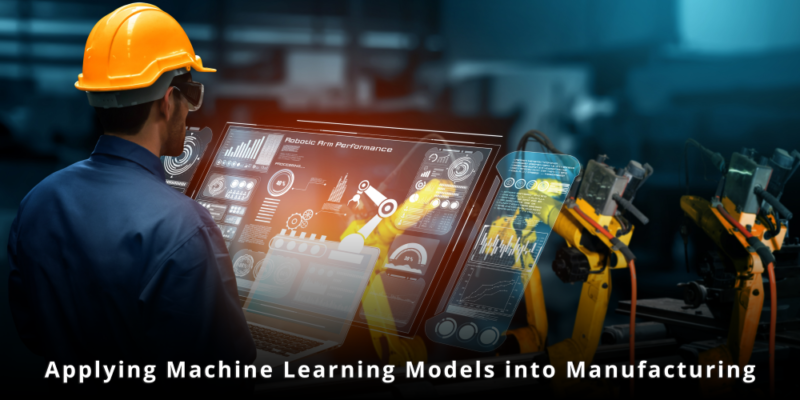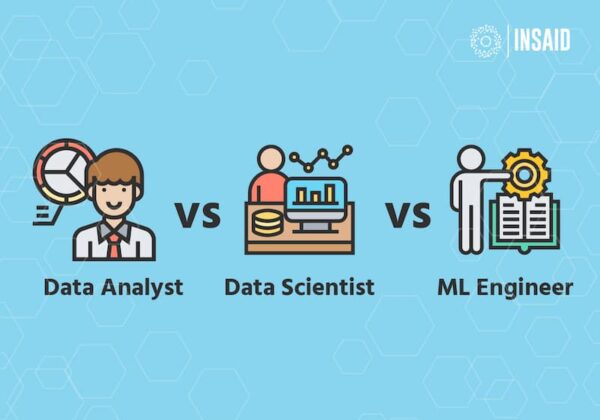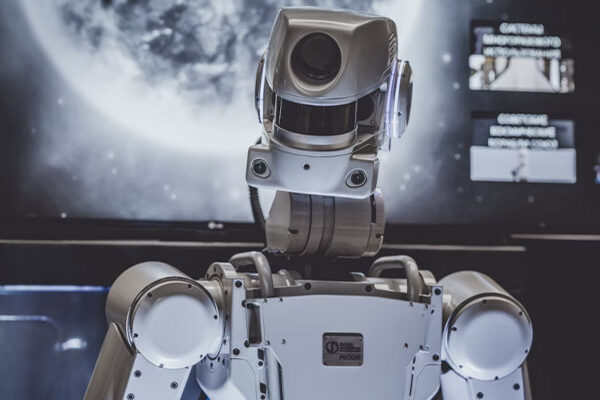Artificial intelligence and machine learning in manufacturing can significantly increase efficiency and help create new business opportunities. To keep up with the latest changes in technology, manufacturers need to explore one of the most critical factors driving factories into the future: machine learning. Due to AI’s high reliance on data, 50% of companies adopting AI have the potential to double their cash flow within the next five to seven years, with manufacturing leading the way across all industries. Let’s talk about the most important applications and innovations that ML technology will provide in 2022.
Table of Contents
How Can AI Help Manufacturing?
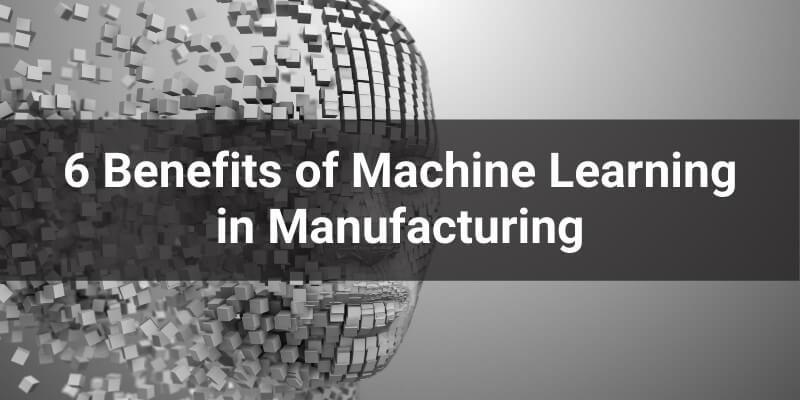
- Quality control
Machine learning models are also used for product inspection and quality control. ML-based computer vision algorithms can learn from historical data to differentiate between good and faulty products, automating the detection and supervision process. These algorithms only require good samples in the training set, and thus do not require a library of possible defects. On the other hand, an algorithm can be developed that compares the samples with the most common defect types. Machine learning offers significant savings for visual quality control in manufacturing. According to Forbes, automated quality testing based on machine learning can increase detection rates by up to 90 percent.
- Robotics
Modern manufacturing still relies heavily on labor. But automation in manufacturing is on the rise, as robots are now able to perform many complex tasks, but a few fields require a very high level of precision that only human experts can provide. A major part of future manufacturing could be taken over by robots that are flexible enough to work alongside humans. They will be able to operate in diverse and dynamic environments with minimal human supervision. Robotics offers excellent opportunities for advanced machine learning techniques to help manufacturers develop complex strategies and manufacturing processes.
- Logistics and inventory management
Manufacturing requires extensive logistics capabilities to run the entire production process. Machine learning-based solutions can automate multiple logistics-related tasks, increasing efficiency and reducing costs. It is estimated that U.S. businesses lose an average of $171,340 per year due to time-consuming manual tasks such as logistics and production-related paperwork. These routine tasks can be automated using machine learning, saving thousands of man-hours each year. Machine learning algorithms can also be used to simplify resource management — Google, for example, was able to reduce its data center cooling bills by 40 percent by using DeepMind artificial intelligence.
- Predictive maintenance
Machine learning enables predictive maintenance by predicting equipment failures before they occur, scheduling timely maintenance, and reducing unnecessary downtime. Manufacturers spend too much time fixing faults instead of allocating resources for planned maintenance. Machine learning algorithms can predict equipment failure with 92 percent accuracy, enabling businesses to plan their maintenance schedules more effectively, improving asset reliability and product quality. Research shows that by deploying machine learning and predictive analytics, overall equipment efficiency has increased from the industry average of 65% to 85%.
- Product development
Product development is one of the most common use cases for machine learning. Whether designing a new product or improving an existing one, extensive data analysis is required for optimal results. Machine learning solutions can help collect and analyze vast amounts of product data to understand consumer needs, uncover hidden flaws, and identify new business opportunities. This helps improve existing product designs and develop better products, creating new revenue streams for businesses. Companies can reduce the risks associated with developing new products because they can make smarter decisions and have better insights.
- Network Security
Machine learning solutions rely on networks, data, and technology platforms (both on-premises and in the cloud) to function effectively. The security of these systems and data is critical, and machine learning can play an important role by regulating access to valuable digital platforms and information. Machine learning can simplify how individual users access sensitive data, the applications they use, and how they connect to sensitive data. This can help companies protect their digital assets by quickly detecting anomalies and triggering corrective actions immediately.
How is AI Used in Manufacturing Industry
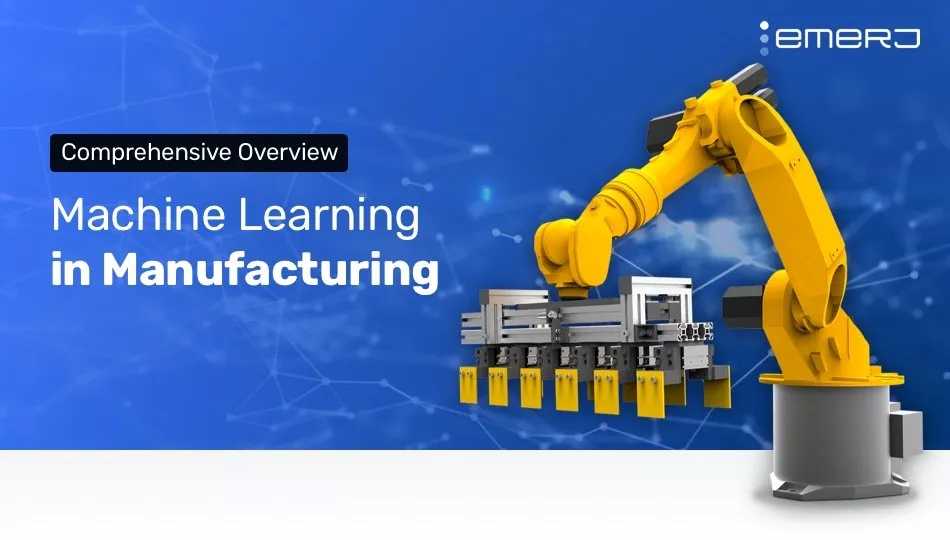
Manufacturing is one of the major industries that makes the most of artificial intelligence and machine learning technologies. Smart factories, also known as Smart Factory 4.0, can greatly reduce unplanned downtime, improve product design, increase efficiency and transition times, and improve overall product quality and worker safety. Artificial intelligence is at the heart of Industry 4.0, delivering higher productivity while remaining environmentally friendly.
Industry giants such as Siemens, General Electric, Fanuc, KUKA, Bosch, Microsoft, and Nvidia. They have invested heavily in AI manufacturing, using machine learning methods to power various parts of manufacturing. TrendForce estimates that smart manufacturing (the combination of industrial AI and IoT) will expand massively over the next three to five years. By 2020, the global smart manufacturing market value will exceed $320 billion, with a compound annual growth rate of 12.5%. In 2015, the number of industrial robots operating in factories was 1.6 million; in 2019, that number is expected to rise to 2.6 million, according to the International Federation of Robotics. According to Google Trends, people searched for “artificial intelligence in manufacturing” more than ever in 2019.
Applications of ML in Manufacturing
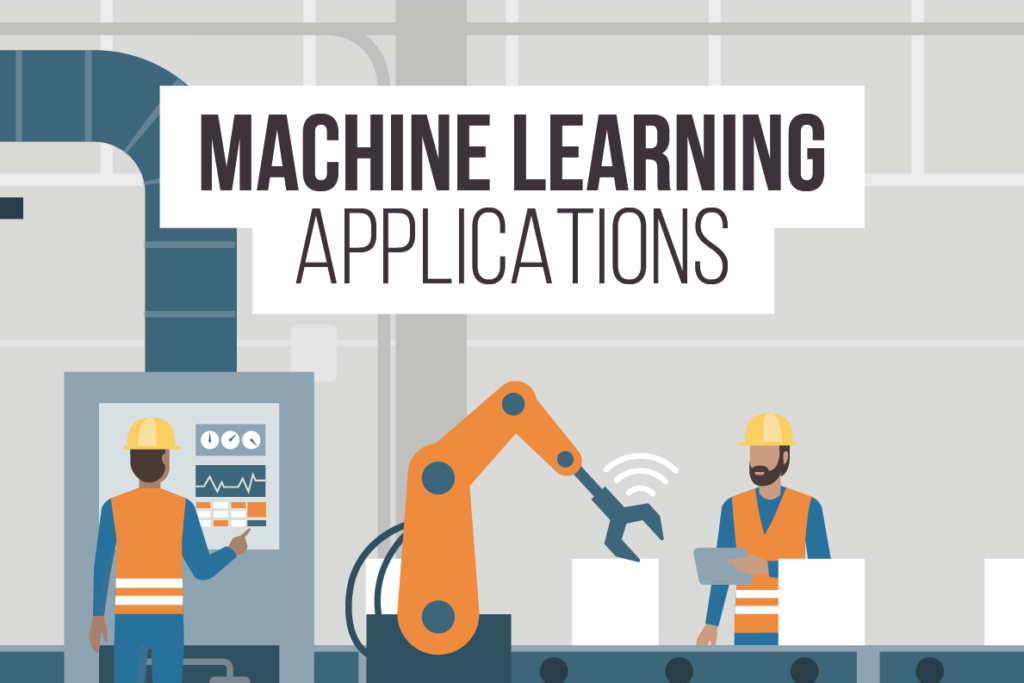
Siemens
The German conglomerate claims that its hands-on experience with industrial artificial intelligence in manufacturing has driven the development and application of the technology. For decades, they have used neural networks to monitor steel plants and improve their performance. Over the past 10 years, they have invested more than $10 billion to acquire software companies.
In 2016, Siemens launched Mindsphere, an intelligent cloud that enables manufacturers to monitor global fleets of machines. That same year, they added IBM’s Watson Analytics to the functionality offered by the service. The purpose of this solution is to capture every parameter of the manufacturing process from development to delivery and find problems and solutions.
Siemens uses neural network-based artificial intelligence in its gas turbines. Over 500 sensors monitor various parameters, and the system learns and decides to adjust the fuel value for the most efficient performance.
Siemens also offers Click2Make, a product designed to enable mass customization. This will be possible when companies fully understand their resources and have cutting-edge robots. To illustrate this, imagine a company that needs to offer limited-edition chairs. All the company has to do is upload the design, and the system feeds that information to a factory that has all the necessary tools. After the factory starts production, company management can search for potential buyers in real-time. This greatly facilitates the process from design to delivery.
General Electric Company
One of the world’s largest companies, GE makes everything from home appliances to large industrial machinery. They have more than 500 factories around the world, but they are just starting to make it smart.
The Brilliant Manufacturing Suite is GE’s attempt to track and process everything in every aspect of manufacturing to find all possible problems and failures. Thanks to this solution, their first brilliant factory in India received a $200 million investment and increased the factory’s efficiency by 18%. GE’s Brilliant Manufacturing Suite is designed to connect all elements of manufacturing, such as design, engineering, or distribution, into one scalable global intelligent system. It even has its own industrial IoT platform, Predix. The platform uses sensors to monitor various aspects of the manufacturing process and the performance of complex equipment. Predix has deep learning capabilities to process all the information and come up with actionable insights. GE has invested more than $1 billion in the system, and by 2020, Predix will process more than 1 million terabytes of information per day.
Currently, GE operates seven splendid plants using the Predix system; all are seeing positive improvements in production.
Fanuk
A company from Japan implements artificial intelligence to make robots smarter. In fact, it is a leader in industrial robotics by incorporating deep learning into robotics. In partnership with Rockwell and Cisco, Fanuc launched Fanuc Intelligent Edge Link and Drive (FIELD), an IoT platform for manufacturing. The partnership with NVIDIA has led to the use of Fanuc’s AI chips in the Factory of the Future. The use of deep reinforcement learning has enabled some industrial robots to train themselves. FANUC and NVIDIA aim to enable multiple robots to learn simultaneously. If the robots can learn together, each robot will learn faster individually. In the future, robots will be able to share their skills with each other, saving time in the manufacturing process in smart factories.
Big Data in Manufacturing: 10 Use Cases
- Improved extraction process
A precious metals manufacturer experienced a decline in ore grades. The obvious solution to this problem is to improve the metal extraction and refining process. Using data from sensors, big data solutions detect factors that affect the output process. The most critical factor is the oxygen content. Armed with this information, the team adjusted the leaching process, resulting in a 3.7 percent increase in yield. Ore grades degrade at a rate of 20%, but big data analytics eliminates this, bringing manufacturers an additional $10-20 million per year.
- Perfect chemical yields
A top European chemical manufacturer has set a goal to increase production. Their big data solutions use sensor data to analyze every factor that affects production output. These factors include CO2 flow, coolant pressure, quantity, and temperature. These ratios are compared to each other. The carbon dioxide flow rate proved to be the decisive factor. With appropriate parameter changes, raw material waste was reduced by 20%, energy costs were reduced by 15%, and yields were significantly increased.
- Increase vaccine production
A pharmaceutical giant is looking for a way to increase vaccine production through big data solutions. By analyzing sensor data from devices, revealing interdependencies and comparing different parameters, the most important elements were discovered, reviewed and tuned. This has resulted in a 50% increase in vaccine production and an additional $5 million to $10 million a year for a substance.
- Optimize sugar sweetness
High humidity and poor quality raw materials from a large sugar factory affected the taste of the sugar. Despite external factors, big data solutions have rapidly improved product quality and created uniform sugar standards. Initial problems were resolved, production costs were reduced, workloads were simplified, and customer satisfaction increased.
- Vehicle Quality Assurance
BMW has been using big data to detect flaws in its prototypes since 2014. Data was collected from sensors installed on prototypes during testing, as well as from cars in use. A big data analysis found weaknesses and bugs in prototypes and cars that had already been sold. Engineers have the opportunity to eliminate bugs in prototypes before mass production, reducing the number of future recalls. By doing so, BMW saves lives, builds brand value, and reduces warranty costs.
- Designing a jet engine
Rolls-Royce is a well-known user of big data technology, applying it to the manufacture of new aircraft engines. Big data solutions are controlled at the design stage and terabytes of information are analyzed during simulation. The company knows the strengths and weaknesses of models long before production is planned, which can reduce defects-related costs, improve product quality, and ultimately save lives.
- Extending the enterprise based on data
Big data solutions can answer the question of whether it is profitable to open a new factory somewhere. Predictive models and what-if scenarios based on historical data not only help in forecasting but also in predicting demand for new products or entering new markets.
- Get raw materials
A business is looking for better ways to deliver raw materials and reduce the cost of supply chain failures. Based on the provider’s route details, weather, traffic data and other factors, big data tools integrated with MRP leverage predictive analytics to calculate possible delays. Businesses now operate without disrupting the production process, and downtime costs are significantly reduced.
- Predictive maintenance
Intel’s factory equipment transmits IoT-collected data directly into its big data solutions. By doing so, pattern recognition, visualization and fault detection can be achieved. Engineers there clearly saw trends and knew what to do immediately to prevent critical failures. This predictive maintenance solution reduces reaction time from nearly four hours to half a minute and significantly reduces costs. This saved $100 million in 2017.
- Hull cleaning
A customer asked Caterpillar Marine to analyze how hull cleaning affects fleet performance. The company conducted a sensor-based analysis of ships with and without clean hulls using its big data solution integrated with an asset intelligence platform. After finding certain correlations, Caterpillar Marine recommends cleaning the hull every six months rather than every two years. This allows them to make the most efficient use of the vessel, improving brand image and customer satisfaction.
Deep Learning Manufacturing
Driven by cutting-edge technologies such as manufacturing big data and the Internet of Things, smart facilities are generating manufacturing intelligence that affects the entire organization. Manufacturing today has access to a once-unimaginable amount of sensory data in a variety of formats, structures and semantics. In the process from sensory data to actual manufacturing intelligence, deep learning has received extensive attention as a leading innovation in computational intelligence. Deep learning techniques enable people to automatically learn from data, detect patterns, and make decisions. We can distinguish between different levels of data analysis, including predictive analysis, prescriptive analysis, diagnostic analysis, and descriptive analysis.
- Predictive analytics uses statistical models to predict the likelihood of future production and equipment degradation.
- The prescriptive analysis provides a variety of scenarios for taking action.
- The diagnostic analysis is designed to report the cause of equipment failure.
- The descriptive analysis summarizes what is currently happening by analyzing the operating parameters, environment, and conditions of the product.
Advanced analytics derived from deep learning transform manufacturing into high-performance smart facilities. The benefits are numerous, including lower operating costs, adapting to customer needs, increased productivity, reduced downtime, better visibility, and more value from overall operations.
Conclusion
In conclusion, machine learning is very useful and effective in manufacturing as it occurs at many stages in the factory. Increased productivity, fewer equipment failures, and better distribution resources are just some of the clear benefits of using machine learning in manufacturing. Machine learning can reduce costs and resources in many areas and at many stages. The flexibility of this technology explains its growing popularity as it becomes more user-friendly. For decades, manufacturers have been early adopters of a variety of technologies, from automation to robotics, and complex digital solutions. Today, more and more factories are using machine learning to enhance processes during manufacturing. Year after year, more and more case studies and studies are published providing evidence of its benefits. The challenge is how to apply it to your business/factory.

